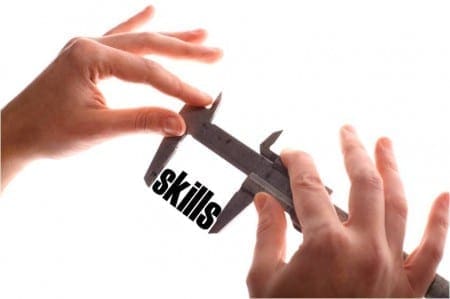How to Measure Workforce Capability
by Stacey Barr |It will be obvious to you how to measure workforce capability. But given the struggle so many have in measuring it meaningfully, it’s likely only obvious in hindsight; the hindsight of seeing the unpacked thinking process of designing a measure for workforce capability.

It is a thinking process, measure design. It’s not a brain-dump or copy-cat exercise. The thinking process I use to design measures follows two very deliberate, multi-part techniques. But the guts of my measure design thinking process is this:
goal –> result –> evidence –> quantification –> measure
Getting from goal –> result
Workforce capability is not a goal. It’s a theme, a concept, a domain of performance, a bandied-around and over-used phrase that most people find is too broad to pin down with a measure. They end up measuring it with trivial statistics like Number of People Trained. Or what’s easy to measure, like Employee Turnover. Or some vague concept that no-one knows how to quantify, like Employee Talent Index.
But we have no clue if any of these are direct evidence of Workforce Capability, because we don’t really know what Workforce Capability means, in goal or result language. We need to ask ourselves what we really mean. What is the result we’re trying to improve? Perhaps we want to improve the match between our people’s skills and the skills required of their positions. Or perhaps we want to improve the match between our people’s skills and the skills required for our future. Of course, we’d need to be sure we knew (and defined) the skills required, in either case.
Getting from result –> evidence
Only when we can describe our goal in a way that makes its intended result observable in the physical world, can we have any hope of measuring it. Making our goal observable in the physical world means we can recognise if, and to what degree, it’s happening. If it’s not observable, it’s not measurable.
So we now need to describe the evidence that would convince us the result was happening, at least to some degree. What would we see more of? Or less of? What differences would stare us in the face? Perhaps we’d see more people passing tests or exams focused on the skills we need them to have. Perhaps we’d see more people successfully executing the skills we need them to have in carrying out their day to day tasks.
Getting from evidence –> quantification
The building block of any measure is the quantification of some observable evidence. We can’t measure what we can’t observe (either with our natural senses or with instruments that amplify our senses). Data can only be gathered about what we see, feel, hear, touch, taste, or smell. Or by instruments that see, feel, hear, touch, taste, or smell outside the range of our human ability.
Quantifying evidence simply means choosing a data summary technique that tells us “how much?” Perhaps we could quantify the proportion of people who pass tests or exams focused on the skills we need them to have. Or we could quantify the proportion of the workforce that has passed tests or exams focused on the skills we need them to have. Or we could quantify the proportion of people who successfully demonstrate, on the job, the skills we need them to have. Or we could quantify the proportion of total position skills that have been successfully demonstrated by the people in those positions.
Getting from quantification –> measure
A measure is a formalised way of expressing the quantification of some observable evidence. A performance measure is a formalised way of expressing the quantification of some observable evidence about a result that must be improved. This formalisation removes any ambiguity about what exactly the measure is measuring and how it’s doing that measuring.
A good measure is expressed clearly and concisely, but using more words that you’re probably used to. For example, a measure of proportion of total position skills that have been successfully demonstrated by the people in those positions would be expressed like this:
Proportion of Required Skills Attained: The proportion of total position skills required by the organisation, that have been successfully demonstrated by the people currently assigned to those positions.
This measure is better than most default measures of Workforce Capability because it’s clear, quantifiable, and direct evidence of the desired result.
And I’m wrong about this.
The thinking process to design a measure is both about the structure and the content.
The structure is the essential steps of goal –> result –> evidence –> quantification –> measure. You can’t miss one of these steps and produce a good measure.
The content is the goal you’re trying to measure. And defining what you really mean by that goal, in clear results-language and observable evidence, is thinking that will be unique to you. If you want to measure Workforce Capability, and you follow the structure I’ve given, you’ll end up with measures different to mine. But they’ll be the measures that are right for you.
DISCUSSION:
What does Workforce Capability mean to your organisation? Can you explain it in clear results-language? Can you describe the observable evidence that would convince you it was improving?
Connect with Stacey
Haven’t found what you’re looking for? Want more information? Fill out the form below and I’ll get in touch with you as soon as possible.
167 Eagle Street,
Brisbane Qld 4000,
Australia
ACN: 129953635
Director: Stacey Barr




